Village Settlements’ Perspective on Rural Water Accessibility: A Mountainous Water Security Measurement Approach
Abstract
:1. Introduction
2. Materials and Methods
2.1. Study Area
2.2. The Flowchart of RWA Model
2.3. Dataset
2.4. Methods
2.4.1. The Supply–Demand Relation Detection
- The procedure of LCP simulation
- Resistance raster establishment for LCP
- Candidate main/standby water sources
2.4.2. The Water Demand Gap Estimation
2.4.3. Water Availability
2.4.4. Grading the RWA
3. Results
3.1. Demand Gap of VSs under Different Supply Ratios
3.2. Water Availability of Standby Water Sources to VSs
3.3. RWA of VSs
4. Discussion
4.1. Accurate Assessment and Strategic Support of Rural Water Security
4.2. Water Scarcity Prevention and Control in Rural Areas under Extreme Drought
4.3. Uncertainty of the Measurement
5. Conclusions
Supplementary Materials
Author Contributions
Funding
Institutional Review Board Statement
Informed Consent Statement
Data Availability Statement
Conflicts of Interest
References
- Dolan, F.; Lamontagne, J.; Link, R.; Hejazi, M.; Reed, P.; Edmonds, J. Evaluating the Economic Impact of Water Scarcity in a Changing World. Nat. Commun. 2021, 12, 1915. [Google Scholar] [CrossRef]
- Liu, J.; Yang, H.; Gosling, S.N.; Kummu, M.; Flörke, M.; Pfister, S.; Hanasaki, N.; Wada, Y.; Zhang, X.; Zheng, C. Water Scarcity Assessments in the Past, Present, and Future. Earth’s Future 2017, 5, 545–559. [Google Scholar] [CrossRef] [PubMed]
- Yang, H.; Wright, J.A.; Gundry, S.W. Boost Water Safety in Rural China. Nature 2012, 484, 318. [Google Scholar] [CrossRef]
- Piao, S.; Ciais, P.; Huang, Y.; Shen, Z.; Peng, S.; Li, J.; Zhou, L.; Liu, H.; Ma, Y.; Ding, Y. The Impacts of Climate Change on Water Resources and Agriculture in China. Nature 2010, 467, 43–51. [Google Scholar] [CrossRef]
- Wang, Y.; Wang, Y.; Su, X.; Qi, L.; Liu, M. Evaluation of the Comprehensive Carrying Capacity of Interprovincial Water Resources in China and the Spatial Effect. J. Hydrol. 2019, 575, 794–809. [Google Scholar] [CrossRef]
- Drenkhan, F.; Buytaert, W.; Mackay, J.D.; Barrand, N.E.; Hannah, D.M.; Huggel, C. Looking beyond Glaciers to Understand Mountain Water Security. Nat. Sustain. 2023, 6, 130–138. [Google Scholar] [CrossRef]
- Li, J.; Deng, W.; Zhang, J. Evaluating Mountain Water Scarcity on the County Scale: A Case Study of Dongchuan District, Kunming, China. J. Mt. Sci. 2019, 16, 744–754. [Google Scholar] [CrossRef]
- Zhou, F.; Zhang, W.; Su, W.; Peng, H.; Zhou, S. Spatial Differentiation and Driving Mechanism of Rural Water Security in Typical “Engineering Water Depletion” of Karst Mountainous Area—A Lesson of Guizhou, China. Sci. Total Environ. 2021, 793, 148387. [Google Scholar] [CrossRef]
- Wang, W.; Zhao, X.; Cao, J.; Li, H.; Zhang, Q. Barriers and Requirements to Climate Change Adaptation of Mountainous Rural Communities in Developing Countries: The Case of the Eastern Qinghai-Tibetan Plateau of China. Land Use Policy 2020, 95, 104354. [Google Scholar] [CrossRef]
- Mengist, W.; Soromessa, T.; Legese, G. Ecosystem Services Research in Mountainous Regions: A Systematic Literature Review on Current Knowledge and Research Gaps. Sci. Total Environ. 2020, 702, 134581. [Google Scholar] [CrossRef]
- Chaudhary, S.; Tshering, D.; Phuntsho, T.; Uddin, K.; Shakya, B.; Chettri, N. Impact of Land Cover Change on a Mountain Ecosystem and Its Services: Case Study from the Phobjikha Valley, Bhutan. Ecosyst. Health Sustain. 2017, 3, 1393314. [Google Scholar] [CrossRef]
- Li, D.; Wu, S.; Liu, L.; Liang, Z.; Li, S. Evaluating Regional Water Security through a Freshwater Ecosystem Service Flow Model: A Case Study in Beijing-Tianjian-Hebei Region, China. Ecol. Indic. 2017, 81, 159–170. [Google Scholar] [CrossRef]
- Tu, Y.; Wang, H.; Zhou, X.; Shen, W.; Lev, B. Comprehensive Evaluation of Security, Equity, and Efficiency on Regional Water Resources Coordination Using a Hybrid Multi-Criteria Decision-Making Method with Different Hesitant Fuzzy Linguistic Term Sets. J. Clean. Prod. 2021, 310, 127447. [Google Scholar] [CrossRef]
- World Health Organization. Guidelines for Drinking-Water Quality: Incorporating the First and Second Addenda; World Health Organization: Geneva, Switzerland, 2022; ISBN 92-4-004506-6. [Google Scholar]
- Nie, R.; Tian, Z.; Wang, J.; Zhang, H.; Wang, T. Water Security Sustainability Evaluation: Applying a Multistage Decision Support Framework in Industrial Region. J. Clean. Prod. 2018, 196, 1681–1704. [Google Scholar] [CrossRef]
- Romero-Lankao, P.; Gnatz, D.M. Conceptualizing Urban Water Security in an Urbanizing World. Curr. Opin. Environ. Sustain. 2016, 21, 45–51. [Google Scholar] [CrossRef]
- Li, F.; Liu, H.; Chen, X.; Yu, D. Trivariate Copula Based Evaluation Model of Water Accessibility. Water Resour. Manag. 2019, 33, 3211–3225. [Google Scholar] [CrossRef]
- Li, H.; Fan, Y.; Gong, Z.; Zhou, D. Water Accessibility Assessment of Freshwater Wetlands in the Yellow River Delta National Nature Reserve, China. Ecohydrol. Hydrobiol. 2019, 20, 21–30. [Google Scholar] [CrossRef]
- Bross, L.; Krause, S.; Wannewitz, M.; Stock, E.; Sandholz, S.; Wienand, I. Insecure Security: Emergency Water Supply and Minimum Standards in Countries with a High Supply Reliability. Water 2019, 11, 732. [Google Scholar] [CrossRef]
- Berrouet, L.; Villegas-Palacio, C.; Botero, V. Vulnerability of Rural Communities to Change in an Ecosystem Service Provision: Surface Water Supply. A Case Study in the Northern Andes, Colombia. Land Use Policy 2020, 97, 104737. [Google Scholar] [CrossRef]
- Duan, Y.; Yan, L.; Lai, Z.; Chen, Q.; Sun, Y.; Zhang, L. The Spatial Form of Traditional Villages in Fuzhou Area of Jiangxi Province Determined via GIS Methods. Front. Earth Sci. 2022, 1–13. [Google Scholar] [CrossRef]
- Cheng, Q.; Gao, L.; Zhong, F.; Zuo, X.; Ma, M. Spatiotemporal Variations of Drought in the Yunnan-Guizhou Plateau, Southwest China, during 1960–2013 and Their Association with Large-Scale Circulations and Historical Records. Ecol. Indic. 2020, 112, 106041. [Google Scholar] [CrossRef]
- Meza, I.; Eyshi Rezaei, E.; Siebert, S.; Ghazaryan, G.; Nouri, H.; Dubovyk, O.; Gerdener, H.; Herbert, C.; Kusche, J.; Popat, E.; et al. Drought Risk for Agricultural Systems in South Africa: Drivers, Spatial Patterns, and Implications for Drought Risk Management. Sci. Total Environ. 2021, 799, 149505. [Google Scholar] [CrossRef] [PubMed]
- Balbi, M.; Petit, E.J.; Croci, S.; Nabucet, J.; Georges, R.; Madec, L.; Ernoult, A. Ecological Relevance of Least Cost Path Analysis: An Easy Implementation Method for Landscape Urban Planning. J. Environ. Manag. 2019, 244, 61–68. [Google Scholar] [CrossRef] [PubMed]
- Li, S.; Xiao, W.; Zhao, Y.; Lv, X. Incorporating Ecological Risk Index in the Multi-Process MCRE Model to Optimize the Ecological Security Pattern in a Semi-Arid Area with Intensive Coal Mining: A Case Study in Northern China. J. Clean. Prod. 2020, 247, 119143. [Google Scholar] [CrossRef]
- Davarpanah, A.; Vahidnia, M.H. Optimal Route Finding of Water Transmission Lines by Comparing Different MCDM Methods and the Least-Cost Path Algorithm in a Raster (Case Study: From Ardak to Mashhad). Water Resour. Eng. 2022, 14, 39–56. [Google Scholar]
- Yang, J.; Wan, Q.; Han, J.; Xing, S. An Evaluation Model for Automobile Intelligent Cockpit Comfort Based on Improved Combination Weighting-Cloud Model. PLoS ONE 2023, 18, e0282602. [Google Scholar] [CrossRef]
- Guo, S.; Lin, L.; Liu, S.; Wei, Y.; Xu, D.; Li, Q.; Su, S. Interactions between Sustainable Livelihood of Rural Household and Agricultural Land Transfer in the Mountainous and Hilly Regions of Sichuan, China. Sustain. Dev. 2019, 27, 725–742. [Google Scholar] [CrossRef]
- Li, J.; Yang, J.; Liu, M.; Ma, Z.; Fang, W.; Bi, J. Quality Matters: Pollution Exacerbates Water Scarcity and Sectoral Output Risks in China. Water Res. 2022, 224, 119059. [Google Scholar] [CrossRef] [PubMed]
- Yousef, S.F. Water Scarcity and Conflict between Upstream and Downstream Riparian Countries. Water Econ. Policy 2021, 7, 2150012. [Google Scholar] [CrossRef]
- An, M.; Fan, L.; Huang, J.; Yang, W.; Wu, H.; Wang, X.; Khanal, R. The Gap of Water Supply—Demand and Its Driving Factors: From Water Footprint View in Huaihe River Basin. PLoS ONE 2021, 16, e0247604. [Google Scholar] [CrossRef]
- Li, X.; Sun, W.; Zhang, D.; Huang, J.; Li, D.; Ding, N.; Zhu, J.; Xie, Y.; Wang, X. Evaluating Water Provision Service at the Sub-Watershed Scale by Combining Supply, Demand, and Spatial Flow. Ecol. Indic. 2021, 127, 107745. [Google Scholar] [CrossRef]
- Liu, G.; Fu, X.; Han, Q.; Huang, R.; Zhuang, T. Research on the Collaborative Governance of Urban Regeneration Based on a Bayesian Network: The Case of Chongqing. Land Use Policy 2021, 109, 105640. [Google Scholar] [CrossRef]
- Adams, E.A.; Zulu, L.; Ouellette-Kray, Q. Community Water Governance for Urban Water Security in the Global South: Status, Lessons, and Prospects. Wiley Interdiscip. Rev. Water 2020, 7, e1466. [Google Scholar] [CrossRef]
- Chawla, I.; Karthikeyan, L.; Mishra, A.K. A Review of Remote Sensing Applications for Water Security: Quantity, Quality, and Extremes. J. Hydrol. 2020, 585, 124826. [Google Scholar] [CrossRef]
- Lievens, H.; Demuzere, M.; Marshall, H.-P.; Reichle, R.H.; Brucker, L.; Brangers, I.; de Rosnay, P.; Dumont, M.; Girotto, M.; Immerzeel, W.W. Snow Depth Variability in the Northern Hemisphere Mountains Observed from Space. Nat. Commun. 2019, 10, 4629. [Google Scholar] [CrossRef] [PubMed]
- Heidari, H.; Arabi, M.; Warziniack, T. Vulnerability to Water Shortage under Current and Future Water Supply-Demand Conditions across US River Basins. Earth’s Future 2021, 9, e2021EF002278. [Google Scholar] [CrossRef]
- Balaei, B.; Noy, I.; Wilkinson, S.; Potangaroa, R. Economic Factors Affecting Water Supply Resilience to Disasters. Socio-Econ. Plan. Sci. 2021, 76, 100961. [Google Scholar] [CrossRef]
- Mishra, B.K.; Kumar, P.; Saraswat, C.; Chakraborty, S.; Gautam, A. Water Security in a Changing Environment: Concept, Challenges and Solutions. Water 2021, 13, 490. [Google Scholar] [CrossRef]
- He, J.; Li, Y.; Li, X.; Huang, J. Temporal and spatial characteristics of droughts over Yunnan Province during 1961–2012. Mt. Res. 2016, 34, 19–27. [Google Scholar]
- Wang, X.; Zhang, L.; Wang, F. Feasibility study of five drought indices for use in Yunnan Province. J. Irrig. Drain. 2017, 36, 117–124. [Google Scholar]
- Yu, Y.; Chen, X.; Wang, Y.; Mao, J.; Ding, Z.; Lu, Y.; Wang, X.; Lian, X.; Shi, Y. Producing and Storing Self-Sustaining Drinking Water from Rainwater for Emergency Response on Isolated Island. Sci. Total Environ. 2021, 768, 144513. [Google Scholar] [CrossRef] [PubMed]
- Wang, H.; Huang, S.; Di, D.; Wang, Y.; Zhang, F. Study on the Spatial Distribution of Water Resource Value in the Agricultural System of the Yellow River Basin. Water Policy 2021, 23, 1044–1058. [Google Scholar] [CrossRef]
- Wu, Y.; Li, X.; Yu, L.; Wang, T.; Wang, J.; Liu, T. Review of Soil Heavy Metal Pollution in China: Spatial Distribution, Primary Sources, and Remediation Alternatives. Resour. Conserv. Recycl. 2022, 181, 106261. [Google Scholar] [CrossRef]
- Sun, S.; Zhou, X.; Liu, H.; Jiang, Y.; Zhou, H.; Zhang, C.; Fu, G. Unraveling the Effect of Inter-Basin Water Transfer on Reducing Water Scarcity and Its Inequality in China. Water Res. 2021, 194, 116931. [Google Scholar] [CrossRef] [PubMed]
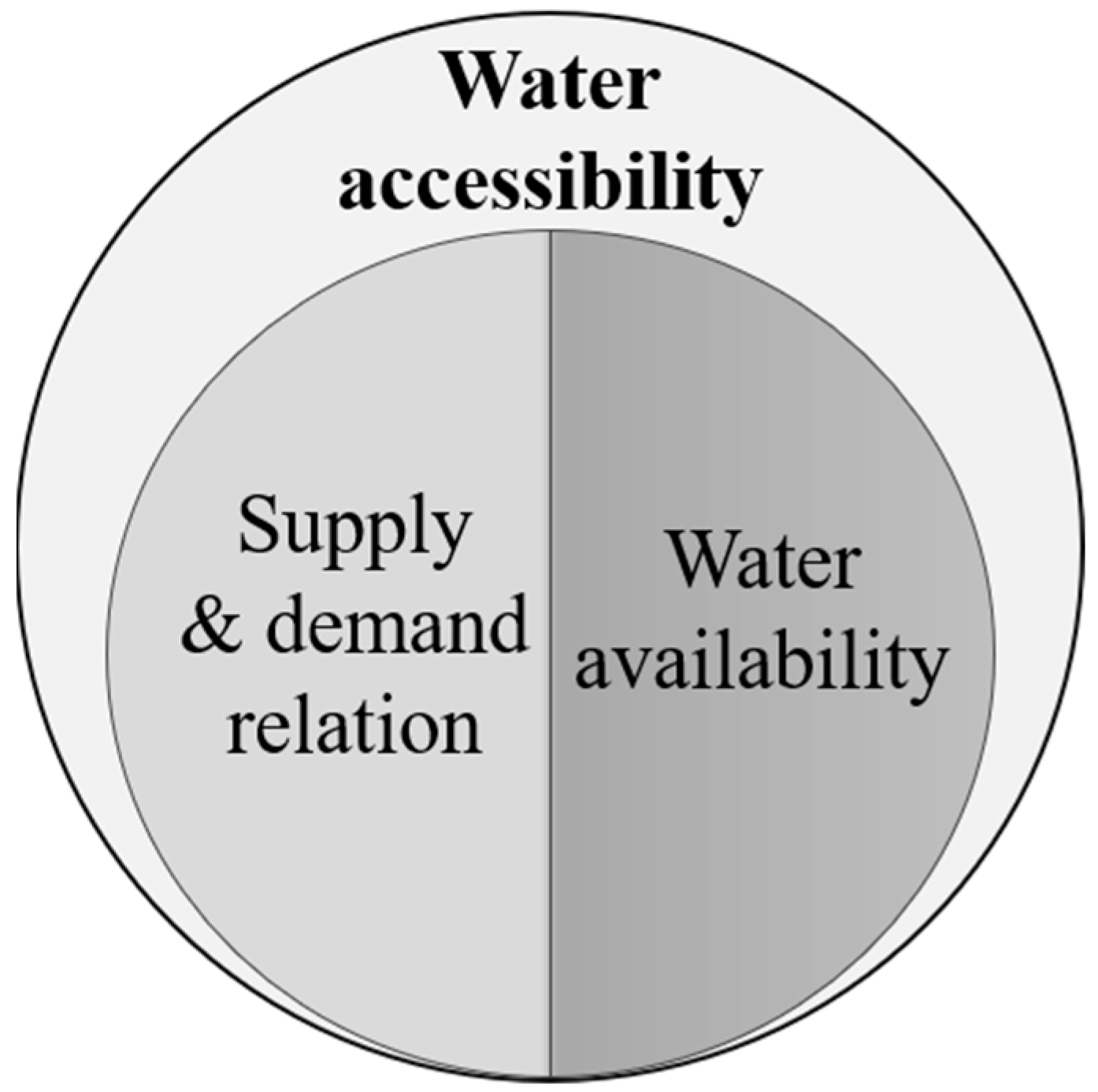
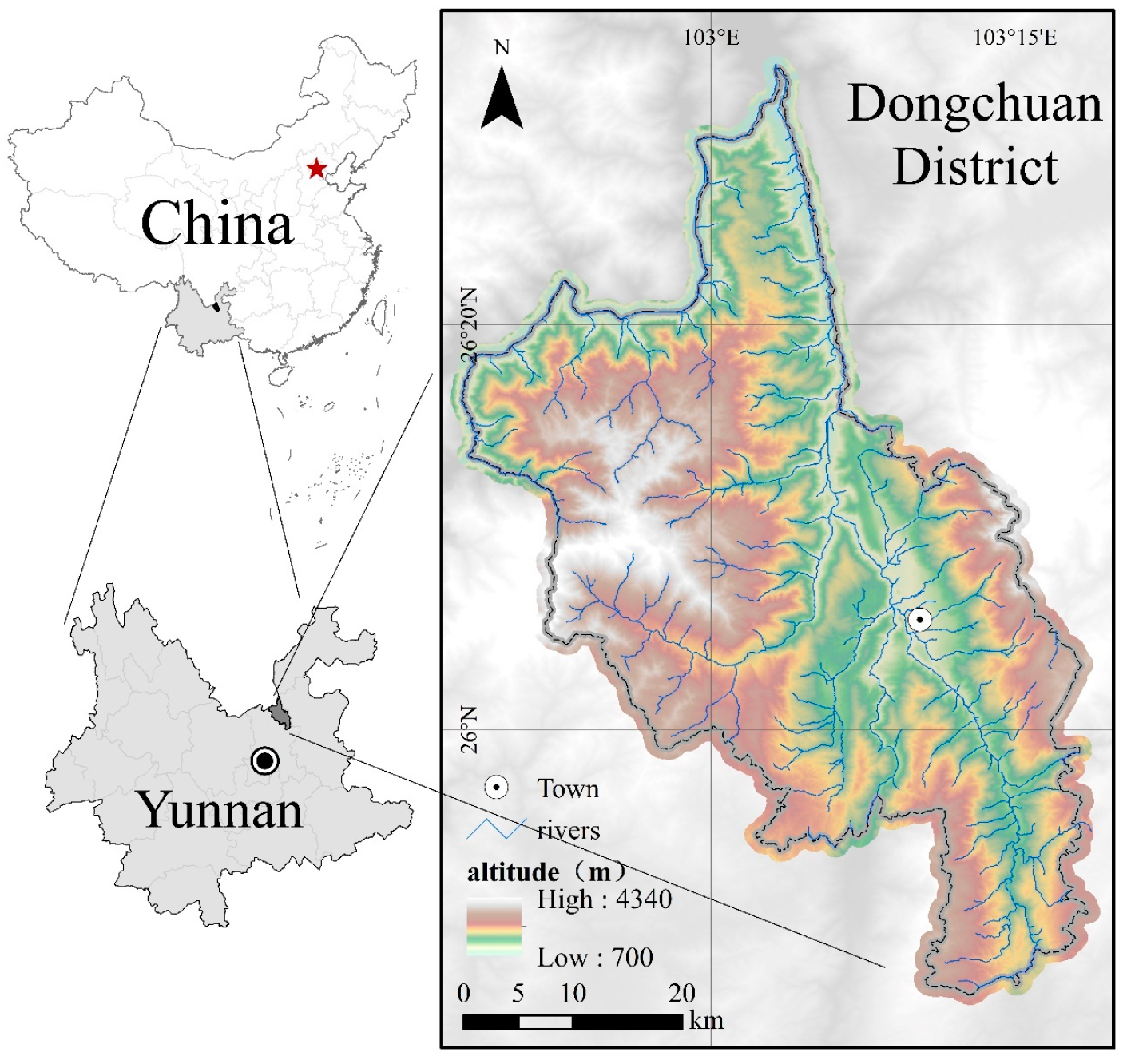

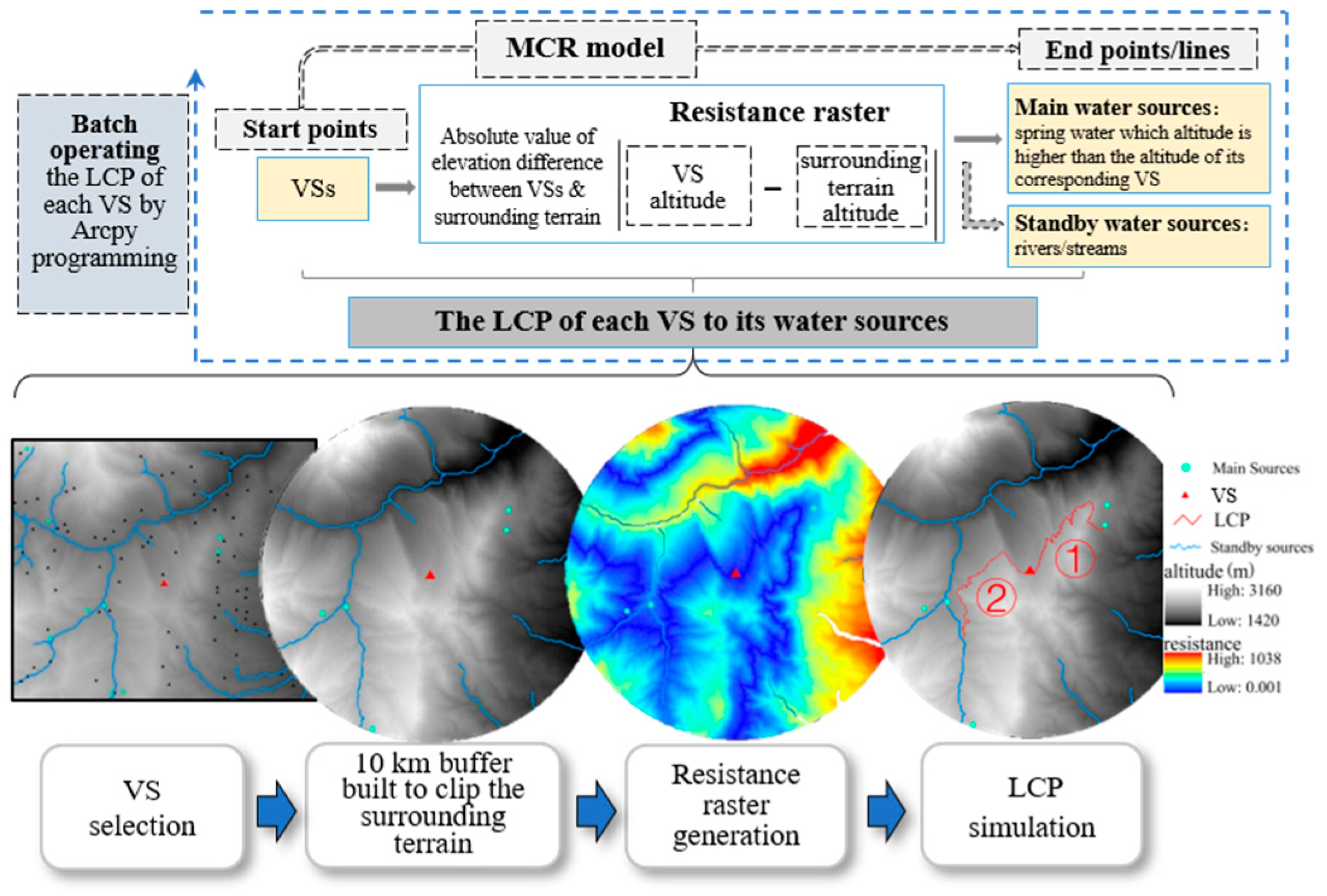

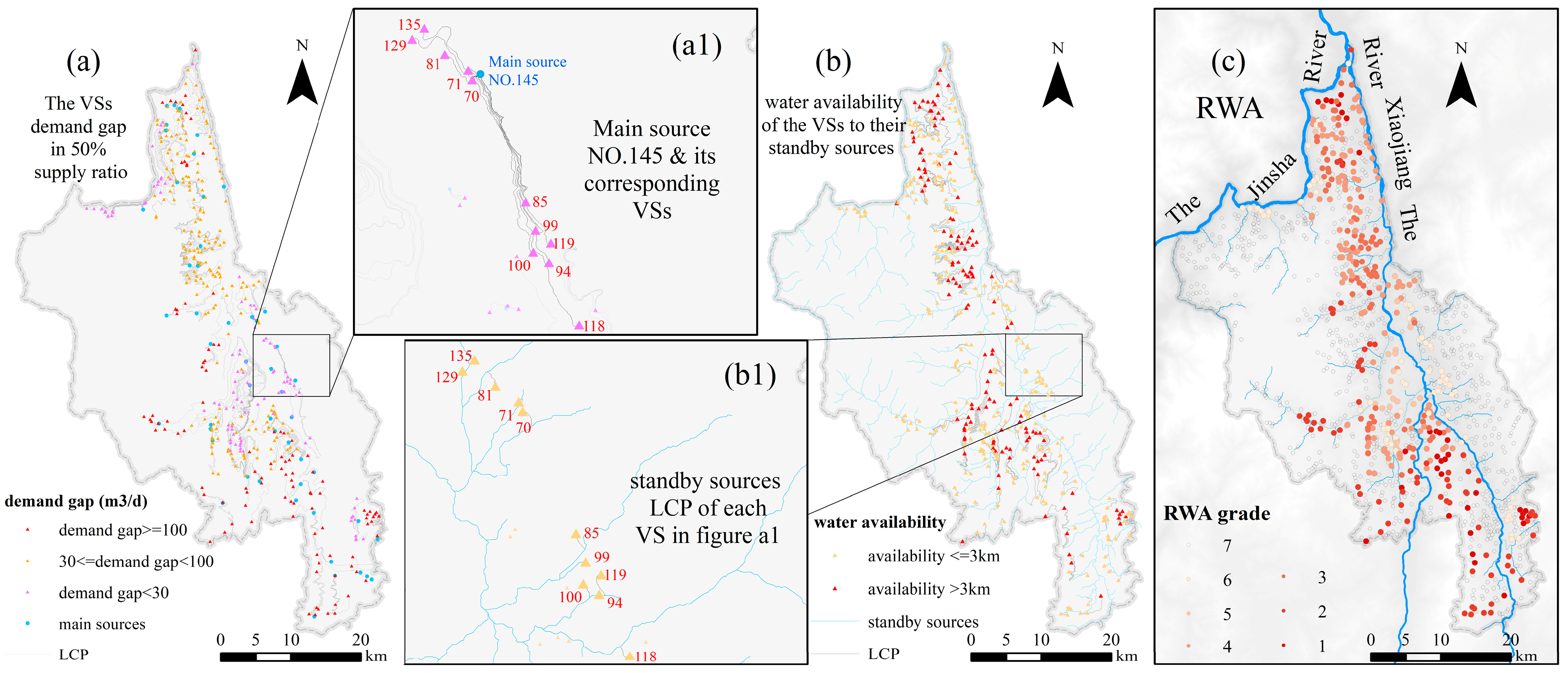

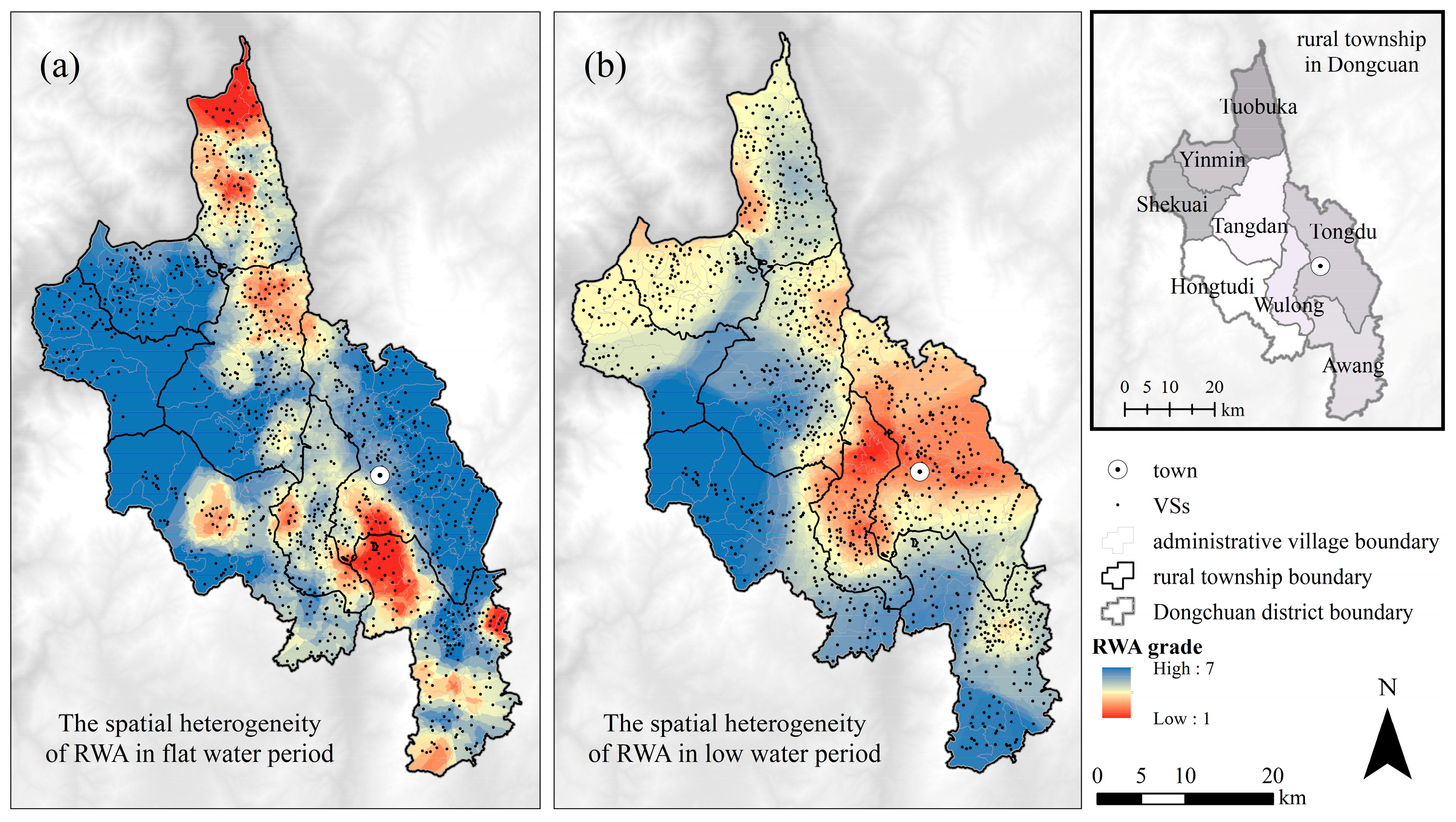
| ID | Data Name | Type | Spatial Resolution | Source | Utilization |
|---|---|---|---|---|---|
| 1 | ASTER Global Digital Elevation Model Version 3 (ASTER GDEM V3) | Raster | 30 m | Geospatial Data Cloud Platform (https://www.gscloud.cn/ (accessed on 6 April 2024)) | Calculate the resistance raster to simulate mountainous geomorphic features in the study area. |
| 2 | VSs | Vector (points) | Peking University Geographic Data Platform (https://opendata.pku.edu.cn/ (accessed on 6 April 2024)) | To determine the spatial location of the VSs. | |
| 3 | Springs location and water resources data | Vector (points) and discharge volume | / | Kunming Groundwater Resources Plan | To determine the spatial location and the supply side of the main water resources. |
| 4 | Rivers/streams with perennial water | Vector (line) | Dongchuan District Natural Resources Bureau | To characterize the spatial location of standby water sources. | |
| 5 | Population density (2020) | Raster | 100 m | Worldpop (https://www.worldpop.org/ (accessed on 6 April 2024)) | To determine the demand side of VSs. |
| 6 | Construction land area of each VS | Text | / | Natural Resources Bureau of Dongchuan District, Kunming | To determine the demand side of VSs. |
| “VS-Main Water Sources” Demand Gap (m3/d) | “VS-Standby Water Sources” Water Availability (km) | RWA Grade |
|---|---|---|
| 0 | - | 7 |
| >0 and <30 m3/d | ≤3 | 6 |
| >3 | 5 | |
| ≥30 and <100 m3/d | ≤3 | 4 |
| >3 | 3 | |
| ≥100 m3/d | ≤3 | 2 |
| >3 | 1 |
| Main Water Source Characteristics | Flat-Water Period | Low-Water Period | VS Characteristics | Quantities | Supply–Demand Characteristics | Quantities |
|---|---|---|---|---|---|---|
| Number of main water sources available | 209 | 208 | Total VSs | 1156 | Total VS water demand | 11,442.4 |
| Total supply | 593,698.8 | 414,015.2 | Total VS population | 104,022 | Maximum VSs supplied | 34 |
| Average supply | 2840.7 | 1980.9 | Average VS population | 497.7 | Mean VSs supplied | 5.2 |
| Maximum supply | 82,643.3 | 53,602.2 | Maximum VS population | 10,471 | The ratio of supply to demand during flat-water period | 5188.6 |
| Supply standard deviation | 9779.1 | 7104.8 | VS population standard deviation | 1265.6 | The ratio of supply to demand during low-water period | 3618.3 |
| Flat-Water Period | Low-Water Period | ||||||
|---|---|---|---|---|---|---|---|
| Grade | Number/ Percentage | Grade | Number/ Percentage | Grade | Number/Percentage | Grade | Number/ Percentage |
| 7 | 749/64.8% | 3 | 77/6.7% | 7 | 630/54.5% | 3 | 79/6.8% |
| 6 | 79/6.8% | 2 | 70/6.1% | 6 | 142/12.3% | 2 | 84/7.3% |
| 5 | 22/1.9% | 1 | 35/3.0% | 5 | 59/5.1% | 1 | 21/1.8% |
| 4 | 124/10.7% | - | - | 4 | 140/12.1% | - | - |
Disclaimer/Publisher’s Note: The statements, opinions and data contained in all publications are solely those of the individual author(s) and contributor(s) and not of MDPI and/or the editor(s). MDPI and/or the editor(s) disclaim responsibility for any injury to people or property resulting from any ideas, methods, instructions or products referred to in the content. |
© 2024 by the authors. Licensee MDPI, Basel, Switzerland. This article is an open access article distributed under the terms and conditions of the Creative Commons Attribution (CC BY) license (https://creativecommons.org/licenses/by/4.0/).
Share and Cite
Li, J.; Qiao, R.; Liu, L.; Wu, K.; Du, P.; Ye, K.; Deng, W. Village Settlements’ Perspective on Rural Water Accessibility: A Mountainous Water Security Measurement Approach. Sustainability 2024, 16, 4372. https://doi.org/10.3390/su16114372
Li J, Qiao R, Liu L, Wu K, Du P, Ye K, Deng W. Village Settlements’ Perspective on Rural Water Accessibility: A Mountainous Water Security Measurement Approach. Sustainability. 2024; 16(11):4372. https://doi.org/10.3390/su16114372
Chicago/Turabian StyleLi, Jie, Ruijing Qiao, Lexuan Liu, Kai Wu, Pengbo Du, Kun Ye, and Wei Deng. 2024. "Village Settlements’ Perspective on Rural Water Accessibility: A Mountainous Water Security Measurement Approach" Sustainability 16, no. 11: 4372. https://doi.org/10.3390/su16114372






